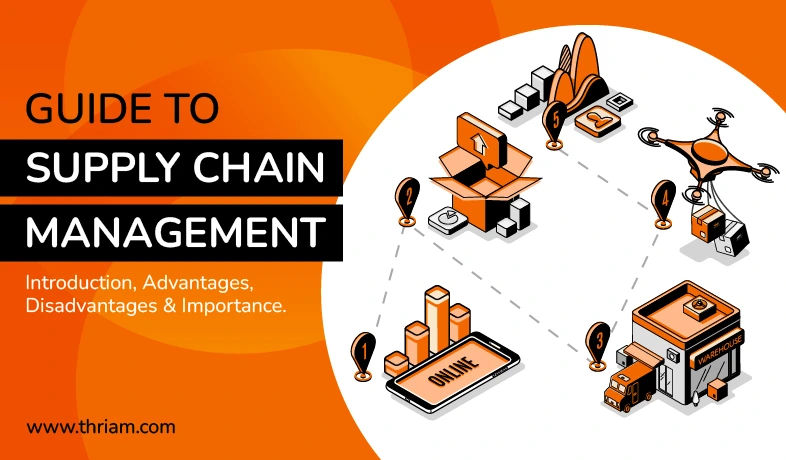Guide to Supply Chain Management

Introduction:
Supply chain management refers to the coordination and integration of various activities involved in the production, sourcing, manufacturing, delivery, and return of goods or services. It involves the seamless flow of materials, information, and finances between suppliers, manufacturers, distributors, retailers, and customers. Supply chain management plays a crucial role in ensuring the efficient and effective movement of goods and services from the point of origin to the point of consumption.
Steps involved in Supply Chain Management
1. Planning

- Forecast customer demand to determine the quantity and timing of production.
- Develop a production plan that optimizes resources and minimizes costs.
- Set inventory levels and establish safety stock to avoid stockouts.
- Develop a demand management strategy to align supply with demand fluctuations.
2. Sourcing

- Identify and select reliable suppliers who can provide the necessary materials or components.
- Establish long-term supplier relationships based on trust and mutual benefits.
- Negotiate favorable terms and conditions, including pricing, delivery schedules, and quality requirements.
- Monitor supplier performance and implement corrective actions when necessary.
3. Manufacturing

- Convert raw materials into finished products according to the production plan.
- Implement quality control measures to ensure that products meet specifications.
- Optimize production processes to minimize waste and maximize efficiency.
- Develop contingency plans to address potential disruptions in the manufacturing process.
4. Delivery

- Coordinate transportation activities to ensure timely and cost-effective delivery of goods.
- Optimize transportation routes and modes to minimize transit time and reduce costs.
- Track and trace shipments to provide visibility throughout the supply chain.
- Collaborate with logistics partners to streamline delivery operations.
5. Return

- Establish a customer-oriented returns management process to handle product returns.
- Analyze the reasons for returns and take corrective actions to prevent future occurrences.
- Implement reverse logistics processes to ensure the efficient and cost-effective handling of returned goods.
- Use returned products for refurbishment or recycling to minimize waste.
Advantages and Disadvantages of Supply Chain Management
Advantages of supply chain management
Improved Customer Service and Satisfaction:
- Timely Delivery: Effective supply chain management ensures products are delivered to customers on time, leading to increased customer satisfaction and loyalty.
- Reliable Delivery: By optimizing transportation and logistics processes, supply chain management minimizes delays and ensures consistent delivery performance.
- Accurate Order Fulfillment: Efficient supply chain management reduces order processing errors, resulting in accurate and complete order fulfillment.
Cost Reduction:
- Inventory Optimization: Supply chain management helps optimize inventory levels to avoid excessive holding costs while ensuring sufficient stock to meet customer demand.
- Supplier Management: Effective supplier management, including negotiation and strategic sourcing, helps companies obtain better pricing, terms, and discounts, leading to cost savings.
- Operational Efficiency: Streamlining processes and reducing waste in the supply chain can lead to cost reductions in areas such as production, transportation, and warehousing.
Enhanced Coordination and Collaboration:
- Improved Communication: Supply chain management facilitates better communication and information sharing among supply chain partners, leading to improved coordination and collaboration.
- Visibility and Transparency: By providing real-time visibility of inventory, production, and logistics data, supply chain management enables better decision-making and coordination.
- Alignment of Goals: Effective supply chain management aligns the goals and objectives of different supply chain partners, encouraging collaborative efforts to achieve shared outcomes.
Increased Flexibility and Adaptability:
- Responsiveness to Demand Fluctuations: Supply chain management enables organizations to adapt quickly to changes in customer demand, whether it's scaling up production or adjusting inventory levels.
- Quick Response to Market Trends: With efficient supply chain management processes, companies can respond promptly to changes in market trends, customer preferences, and competitive landscapes.
- Agility in Supply Chain Operations: Effective supply chain management fosters agility and flexibility in supply chain operations, allowing organizations to quickly adjust to unforeseen events, disruptions, or new opportunities.
Risk Mitigation and Management:
- Supply Chain Resilience: Through effective risk assessment and proactive risk management strategies, supply chain management helps organizations build resilience to mitigate potential disruptions.
- Supply Chain Visibility: Enhanced supply chain visibility allows companies to identify potential risks and take timely preventive actions.
- Collaborative Risk Sharing: Supply chain management encourages collaboration and information exchange among supply chain partners, enabling shared responsibility and risk allocation.
Improved Product Quality and Innovation:
- Quality Control: Supply chain management helps implement quality control measures throughout the supply chain, ensuring consistent product quality and compliance with standards.
- Supplier Performance Monitoring: Effective supply chain management includes monitoring supplier performance, incentivizing continuous improvement, and addressing quality issues promptly.
- Innovation and New Product Development: By fostering collaboration and information exchange, supply chain management promotes innovation and the development of new products or services.
Disadvantages of supply chain management
Increased Complexity:
- Multiple Stakeholders: Supply chain management involves coordination and collaboration among various stakeholders, such as suppliers, manufacturers, distributors, and retailers, which can lead to increased complexity in managing relationships and information flow.
- Interdependencies: The interconnected nature of supply chain processes means that disruptions or failures in one area can have a cascading effect on the entire supply chain, requiring careful management and mitigation strategies.
Higher Management and Coordination Requirements:
- Resource Allocation: Supply chain management requires dedicated resources, including personnel, technology, and infrastructure, which may require additional investments and ongoing management.
- Communication and Coordination Challenges: Effective supply chain management involves clear and timely communication, coordination, and alignment of goals among multiple stakeholders, which can be challenging to achieve.
Reliance on External Partners:
- Dependency on Suppliers: Organizations depend on suppliers to provide timely delivery of materials or components, maintain quality standards, and meet production requirements. Any issues with suppliers, such as capacity constraints or disruptions, can impact the organization's ability to meet customer demand.
- Outsourced Logistics: Many organizations outsource logistics operations to third-party providers. While this can offer expertise and cost savings, it also involves relinquishing direct control over crucial supply chain activities.
Potential Risks and Disruptions:
- Supply Chain Vulnerabilities: Supply chain management involves inherent risks, such as natural disasters, geopolitical events, economic fluctuations, and supplier failures, which can disrupt operations and impact customer service and financial performance.
- Lack of Supply Chain Visibility: Limited visibility across the supply chain can make it challenging to identify and mitigate risks effectively, leading to potential disruptions or inefficiencies.
Technology and Infrastructure Investment:
- Initial Investment: Implementing supply chain management systems and technologies often requires significant upfront investment in software, hardware, and IT infrastructure.
- Ongoing Maintenance and Upgrades: Organizations need to regularly invest in the maintenance, upgrades, and training necessary to keep supply chain management systems effective and up to date.
Potential Negative Environmental and Social Impacts:
- Carbon Footprint: Supply chain management involves transportation, warehousing, and manufacturing activities that can contribute to carbon emissions and impact environmental sustainability goals.
- Social Responsibility: Organizations need to consider the ethical dimensions of their supply chain, including labor conditions, human rights issues, and sustainability practices, to avoid reputational damage and legal implications.
Real-Life Examples of Effective Supply Chain Management
Case Study 1: Apple Inc.
Apple Inc. is known for its efficient supply chain management, which enables it to deliver its products to customers worldwide in a timely manner. Apple maintains close relationships with its suppliers and has implemented advanced inventory management practices to optimize product availability and reduce lead times.
Case Study 2: Walmart
Walmart is renowned for its effective supply chain management, which allows it to offer low prices, a wide product assortment, and efficient logistics. Walmart collaborates closely with suppliers, implementing technologies such as radio frequency identification (RFID) to improve inventory accuracy and streamline replenishment processes.
Importance of Supply Chain Management
Efficient Production Planning and Scheduling:
- Demand Forecasting: Supply chain management helps manufacturers anticipate customer demand more accurately, enabling them to plan production schedules and allocate resources effectively.
- Optimal Inventory Levels: By managing inventory levels throughout the supply chain, manufacturers can avoid excess stock or stockouts, minimizing carrying costs and ensuring smooth production operations.
Cost Reduction and Resource Optimization:
- Supplier Management: Effective supply chain management involves strategic sourcing and supplier relationship management, helping manufacturers negotiate better prices, terms, and discounts, resulting in cost savings.
- Lean Manufacturing: Supply chain management principles, such as just-in-time (JIT) inventory management and waste reduction techniques, facilitate lean manufacturing practices, leading to cost reduction and improved operational efficiency.
Enhanced Quality Control and Compliance:
- Supplier Qualification and Monitoring: Supply chain management ensures that manufacturers work with reliable suppliers who meet quality standards and comply with regulations. Regular performance monitoring helps maintain consistent product quality.
- Traceability and Compliance: By implementing supply chain management systems, manufacturers can track and trace products throughout the production and distribution processes, ensuring compliance with safety, quality, and regulatory requirements.
Timely Delivery and Customer Satisfaction:
- Order Fulfillment: Supply chain management enables manufacturers to fulfill customer orders accurately and on time, improving customer satisfaction and loyalty.
- Efficient Logistics: By optimizing transportation and distribution processes, supply chain management ensures timely delivery of products to customers, reducing lead times and improving service levels.
Supply Chain Resilience and Risk Management:
- Risk Assessment and Mitigation: Supply chain management supports manufacturers in identifying potential risks, such as supply disruptions, and implementing proactive strategies to mitigate them.
- Supplier Diversification: Effective supply chain management encourages manufacturers to have multiple suppliers for critical components or materials, reducing the risk of reliance on a single supplier and minimizing supply chain disruptions.
Innovation and New Product Development:
- Collaboration with Suppliers: Supply chain management fosters collaboration and information exchange with suppliers, enabling manufacturers to leverage their expertise and support innovation and the development of new products.
- Faster Time to Market: By streamlining supply chain processes, manufacturers can shorten lead times, improve coordination, and accelerate the time to market for new products or product variants.
Sustainable and Socially Responsible Practices:
- Environmental Sustainability: Supply chain management helps manufacturers implement sustainable practices, such as reducing waste, optimizing transportation routes, and selecting eco-friendly packaging materials.
- Social Responsibility: Manufacturers can use supply chain management to ensure ethical and socially responsible practices across their supply chain, addressing labor conditions, human rights issues, and fair trade principles.
Conclusion
Supply chain management is crucial for organizations to streamline their operations, enhance customer satisfaction, and reduce costs. By effectively managing each step in the supply chain process, companies can gain a competitive advantage. As technology continues to advance, supply chain management is expected to evolve further, enabling organizations to achieve even greater efficiencies and responsiveness. It is essential for businesses to stay updated on the latest trends and best practices in supply chain management to remain competitive in the global marketplace.



